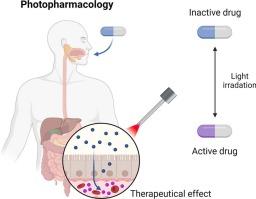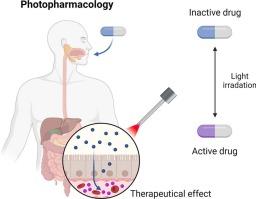光药理学进展:用于精确癌症治疗的荧光光异构体
IF 23.5
1区 化学
Q1 CHEMISTRY, INORGANIC & NUCLEAR
引用次数: 0
摘要
光药理学利用光开关在光照射下可逆地调节药理活性,已成为治疗疾病的一种有前途的策略。与传统的化疗药物相比,光药理学方法提供了对药物激活的精确时空控制,从而减少脱靶毒性,减轻耐药性,并最大限度地减少过度治疗。尽管具有变革潜力,但光药理学在癌症治疗中的应用仍然相对不足。这篇综述旨在巩固该领域的最新进展,特别关注荧光特性在癌症治疗中的作用。我们系统地总结了主要的光异构支架,包括偶氮苯、半靛蓝、二乙烯和螺吡喃,重点介绍了它们的结构特征、在前体构建中的作用、生物成像和功能机制。从实时荧光成像模式到光反应药物平台,这些支架在癌症治疗中显示出显著的优势。这篇综述强调了光药理学在实现精确医学和光引导治疗干预方面的实际潜力。通过强调最近的突破,我们旨在刺激进一步的研究,加速采用创新的肿瘤学光药理学策略,促进临床实践。本文章由计算机程序翻译,如有差异,请以英文原文为准。


Advances in photopharmacology: Fluorescent photoisomers for precision cancer theranostics
Photopharmacology, which utilizes photoswitches to reversibly modulate pharmacological activity upon light exposure, has emerged as a promising strategy in treating diseases. In contrast to conventional chemotherapeutic agents, photopharmacological approaches offer precise spatiotemporal control over drug activation, thereby reducing off-target toxicity, mitigating drug resistance, and minimizing overtreatment. Despite its transformative potential, the application of photopharmacology in cancer theranostics remains relatively underexplored. This review aims to consolidate recent advancements in the field, with a particular focus on the role of fluorescent properties in cancer theranostics. We systematically conclude key photoisomerizable scaffolds, including azobenzene, hemiindigoid, diarylethene, and spiropyran, highlighting their structural features, roles in precursor construction, bioimaging and function mechanisms. These scaffolds demonstrate significant advantages in cancer theranostics, span from real-time fluorescent imaging modalities to photoresponsive drug platforms. This review underscores the practical potential of photopharmacology in enabling precision medicine and light-guided therapeutic interventions. By emphasizing recent breakthroughs, we aim to stimulate further research, accelerate the adoption of innovative photopharmacological strategies in oncology and promote clinical practice.
求助全文
通过发布文献求助,成功后即可免费获取论文全文。
去求助
来源期刊

Coordination Chemistry Reviews
化学-无机化学与核化学
CiteScore
34.30
自引率
5.30%
发文量
457
审稿时长
54 days
期刊介绍:
Coordination Chemistry Reviews offers rapid publication of review articles on current and significant topics in coordination chemistry, encompassing organometallic, supramolecular, theoretical, and bioinorganic chemistry. It also covers catalysis, materials chemistry, and metal-organic frameworks from a coordination chemistry perspective. Reviews summarize recent developments or discuss specific techniques, welcoming contributions from both established and emerging researchers.
The journal releases special issues on timely subjects, including those featuring contributions from specific regions or conferences. Occasional full-length book articles are also featured. Additionally, special volumes cover annual reviews of main group chemistry, transition metal group chemistry, and organometallic chemistry. These comprehensive reviews are vital resources for those engaged in coordination chemistry, further establishing Coordination Chemistry Reviews as a hub for insightful surveys in inorganic and physical inorganic chemistry.
 求助内容:
求助内容: 应助结果提醒方式:
应助结果提醒方式:


